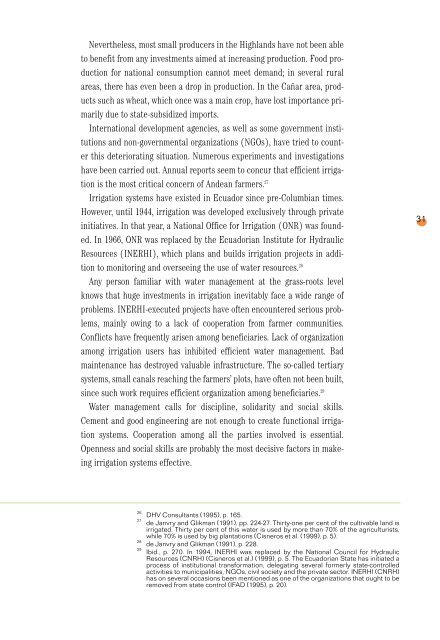mishqui-yacu, sweet water - IFAD
mishqui-yacu, sweet water - IFAD
mishqui-yacu, sweet water - IFAD
Create successful ePaper yourself
Turn your PDF publications into a flip-book with our unique Google optimized e-Paper software.
Nevertheless, most small producers in the Highlands have not been able<br />
to benefit from any investments aimed at increasing production. Food production<br />
for national consumption cannot meet demand; in several rural<br />
areas, there has even been a drop in production. In the Cañar area, products<br />
such as wheat, which once was a main crop, have lost importance primarily<br />
due to state-subsidized imports.<br />
International development agencies, as well as some government institutions<br />
and non-governmental organizations (NGOs), have tried to counter<br />
this deteriorating situation. Numerous experiments and investigations<br />
have been carried out. Annual reports seem to concur that efficient irrigation<br />
is the most critical concern of Andean farmers. 27<br />
Irrigation systems have existed in Ecuador since pre-Columbian times.<br />
However, until 1944, irrigation was developed exclusively through private<br />
initiatives. In that year, a National Office for Irrigation (ONR) was founded.<br />
In 1966, ONR was replaced by the Ecuadorian Institute for Hydraulic<br />
Resources (INERHI), which plans and builds irrigation projects in addition<br />
to monitoring and overseeing the use of <strong>water</strong> resources. 28<br />
Any person familiar with <strong>water</strong> management at the grass-roots level<br />
knows that huge investments in irrigation inevitably face a wide range of<br />
problems. INERHI-executed projects have often encountered serious problems,<br />
mainly owing to a lack of cooperation from farmer communities.<br />
Conflicts have frequently arisen among beneficiaries. Lack of organization<br />
among irrigation users has inhibited efficient <strong>water</strong> management. Bad<br />
maintenance has destroyed valuable infrastructure. The so-called tertiary<br />
systems, small canals reaching the farmers’ plots, have often not been built,<br />
since such work requires efficient organization among beneficiaries. 29<br />
Water management calls for discipline, solidarity and social skills.<br />
Cement and good engineering are not enough to create functional irrigation<br />
systems. Cooperation among all the parties involved is essential.<br />
Openness and social skills are probably the most decisive factors in makeing<br />
irrigation systems effective.<br />
31<br />
26<br />
27<br />
28<br />
29<br />
DHV Consultants (1995), p. 165.<br />
de Janvry and Glikman (1991), pp. 224-27. Thirty-one per cent of the cultivable land is<br />
irrigated. Thirty per cent of this <strong>water</strong> is used by more than 70% of the agriculturists,<br />
while 70% is used by big plantations (Cisneros et al. (1999), p. 5).<br />
de Janvry and Glikman (1991), p. 228.<br />
Ibid., p. 270. In 1994, INERHI was replaced by the National Council for Hydraulic<br />
Resources (CNRH) (Cisneros et al.) (1999), p. 5. The Ecuadorian State has initiated a<br />
process of institutional transformation, delegating several formerly state-controlled<br />
activities to municipalities, NGOs, civil society and the private sector. INERHI (CNRH)<br />
has on several occasions been mentioned as one of the organizations that ought to be<br />
removed from state control (<strong>IFAD</strong> (1995), p. 20).
















